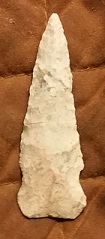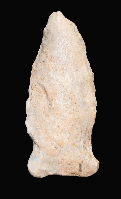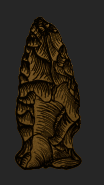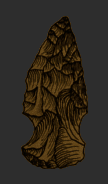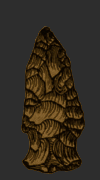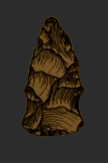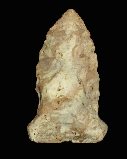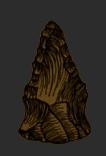Other Websites with Detailed Information:
Name Details:
Named By: Robert L. Stephenson
Named For: Trinity River Valley, Texas
Date Identified: 1949
Type Site:
Trinity
Cluster:
Commonly Utilized Material:
Date:
Cultural Period:
4,000 - 2,000 B.P.
Middle to Late Archaic
Neoglacial to Roman Warm
Glacial Period:
Culture:
Outline is Representative of Size and Shape:
Description of Physical Characteristics and Flaking Pattern:
This is a
thick small to medium triangular side notch point with
an elliptical cross section. The blade is may vary from excurvate to straight.
Broad shallow notches are ground and create weak
shoulders at an upward angle. The stem is broad and expanding with a straight to
strongly convex base. Basal grinding is
commonly seen on this point. This point
commonly is crudely made and has a random flaking pattern.
Size Measurements: 30 to 60 mm (average
40 to 50 mm), Stem Length - 11 to 15 mm (1/4 to 1/3 the total length),
Width - 20 to 25 mm (the width of the blade and the stem are fairly
close. Some examples have a slightly narrower stem than blade
while others they are the same width), Neck Width - 15 to 20 mm (Suhm and Krieger, 1954).
Distribution:
Distribution Comments:
This point is primarily found in the Dallas area
and the East Fork and Trinity River valleys. This point may be
found with decreased frequency into the Red River valley and towards the
Brazo River valley.
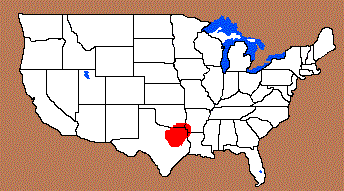
Related / Associated Points:
Additional Comments:
The notches are formed by grinding which causes a broad parallel notch and a weak shoulders.
This point was first described by Stephenson in 1949 for examples found
during his survey of the Trinity River valley. Crook and Harris
provided greater descriptions and distributions of this point in 1952.
Most descriptions of the Trinity point are based on the descriptions of
Crook and Harris (Suhm and Krieger, 1954).
Other points in this Cluster:
Point Validity: Valid Type
Stephenson was a distinguished anthropologist and professor at the
Department of Anthropology, University of South Carolina. This point
was identified while he was working on his masters thesis, and has many
professional references. This is considered a valid type.
.
Age Details:
Pictures Provided By:
As Illustrated by Bell, 1958
Caleb McClain
Caleb Childers
References: (See Reference Page, Entry Number):
8, 23, 30, 44, 115, 177
Trinity Projectile Point, Trinity Arrowhead
